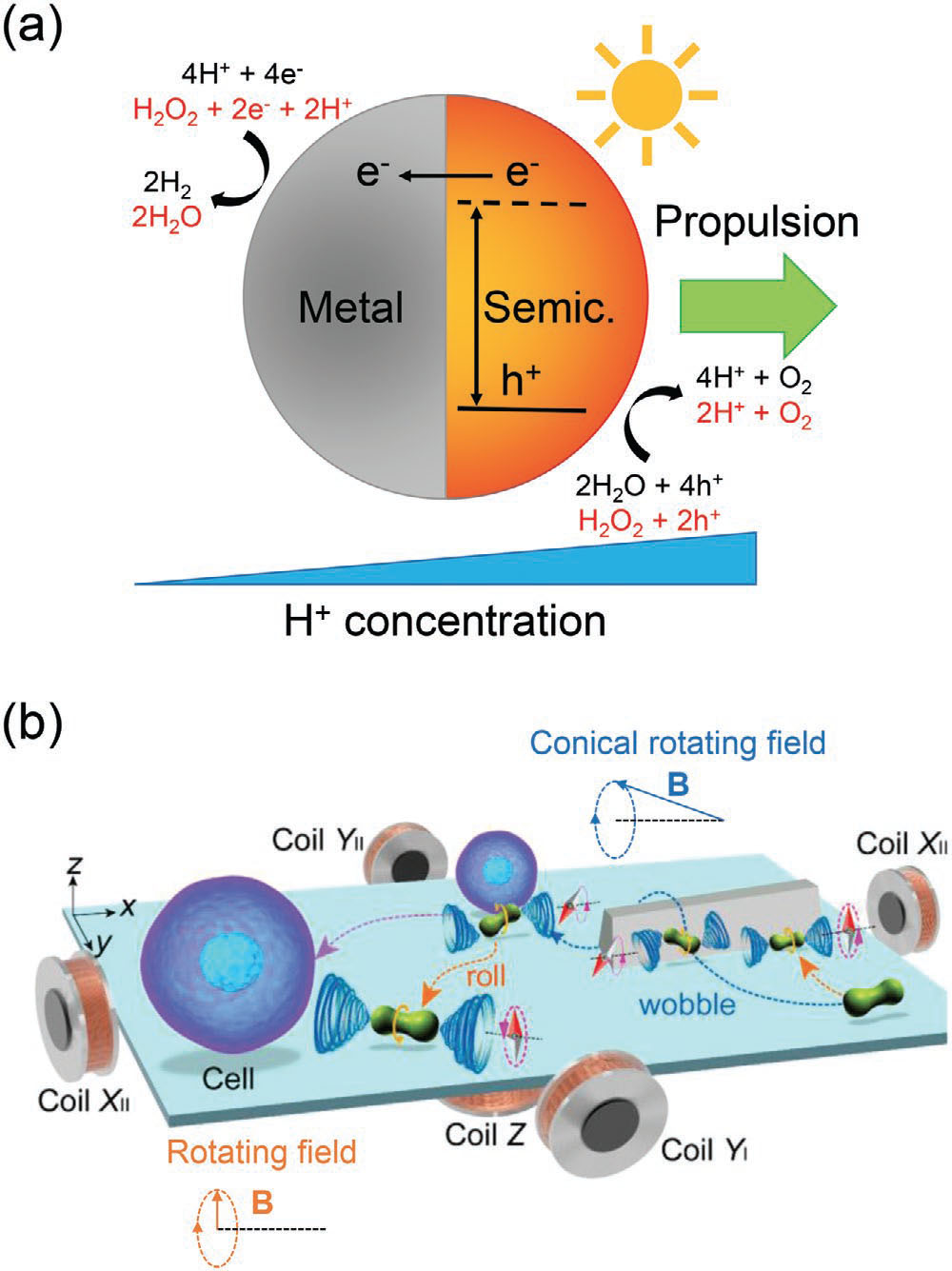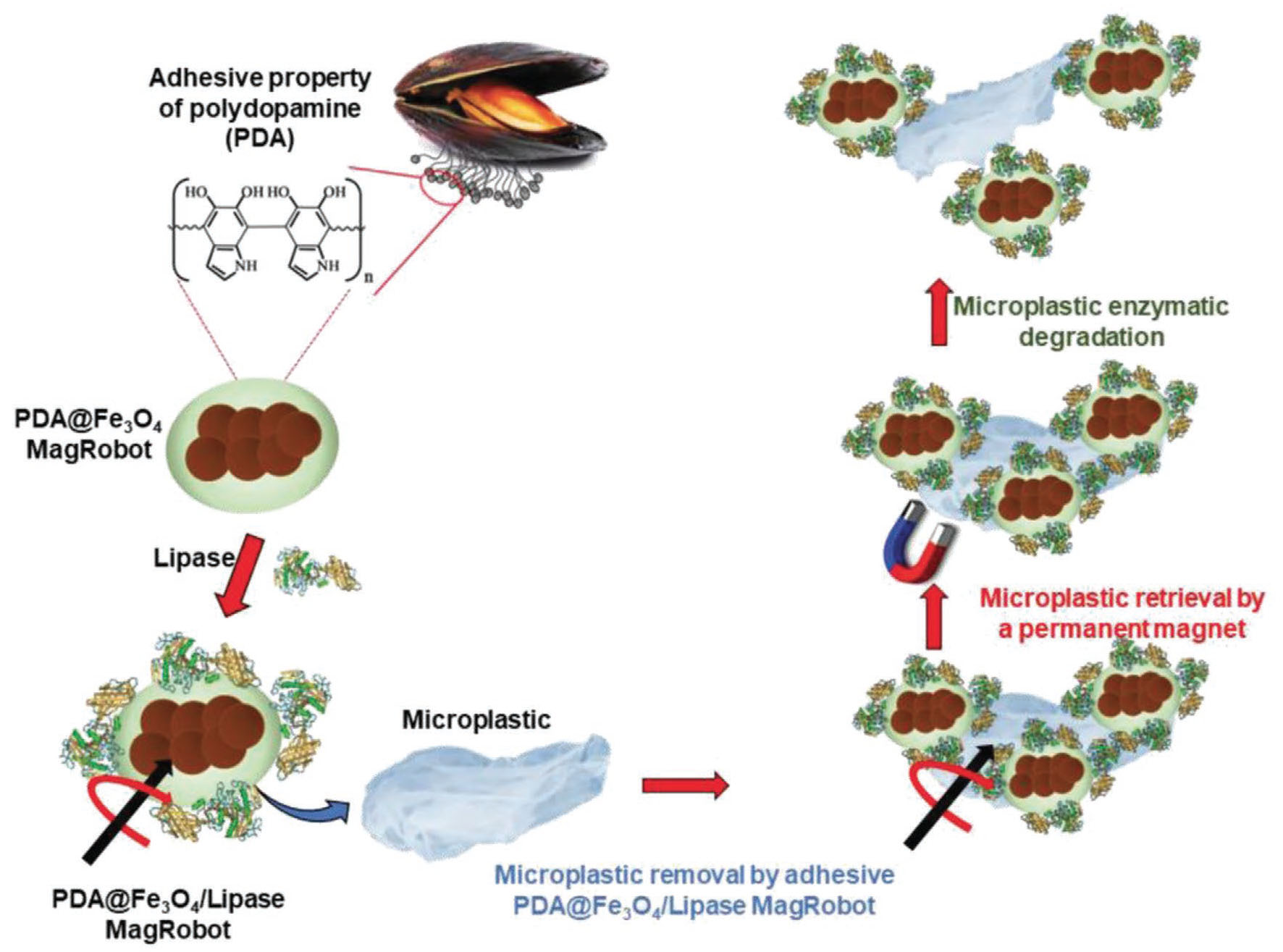| Feb 23, 2022 |
Autonomous micro- and nanobots capture and degrade micro- and nanoplastics
(Nanowerk News) We all are familiar with images of marine environments full of plastic bags, bottles, and other products. However, the real danger associated with plastic pollution results from the gradual fragmentation into smaller particles under the action of the sea and weathering. These degradation processes produce countless tiny plastic particles that can now be detected in virtually all ecosystems.
|
|
Wherever scientists look, they can spot them: whether in remote mountain lakes, in Arctic sea ice, in the deep-ocean floor or in air samples, even in edible fish – thousands upon thousands of microscopic plastic particles. If their size is below 5 millimeters these particles are called microplastics; if their size is below 1 micrometer they are called nanoplastics.
|
|
Nanoplastic pollution, the ultimate product of plastic waste fragmentation in the environment, is an emerging global issue due to their tiny size, which increases their hazard and the difficulty of removing them.
|
|
These small particles are especially concerning because of their high specific surface area for sorption of contaminants and potentially making them even more toxic – as well as their potential to translocate in the bodies of organisms.
|
|
These same small particles are challenging to separate and identify in environmental samples because their size makes handling and observation difficult. As a result, scientists' understanding of the environmental prevalence of nanoplastics and microplastics is limited.
|
|
Recently, many efforts have been devoted to the 'on-the-fly' degradation of microplastics by autonomous motile nanobots and microrobots.
|
|
A recent article in Advanced Functional Materials ("Nano/Microplastics Capture and Degradation by Autonomous Nano/Microrobots: A Perspective") briefly introduces the motion mechanisms of these bots and summarizes the experimental techniques to analyze micro- and nanoplastics. The article describes the most significant advances in micro- and nanorobotics for polymers and plastics capture and degradation.
|
|
Micro- and nanorobots can be categorized into two main groups, depending on whether their self-propulsion is obtained by external energy sources or by consuming chemical fuels, as bacteria do. Light, especially sunlight, is a powerful and abundant energy source to power nano/microrobots.
|
|
Magnetic nano/microrobots offer the advantage of precise navigation, which is helpful in biomedicine and microplastics removal. They can be manipulated to reach targeted microplastics, capture, and collect them. Moreover, magnetic fields can produce and control swarms of nano/microrobots to perform complex tasks that single entities cannot accomplish.
|
 |
| Schematic illustrations of a) light-driven propulsion mechanism of metal/semiconductor Janus nano/microrobots and b) magnetically actuated microrobots moving in rolling and wobbling modes under rotating magnetic fields for cell manipulation. (Reprinted with permission by Wiley-VCH Verlag)
|
|
Bots employed in plastic waste capture and degradation are principally propelled by photocatalytic reactions, eventually in the presence of H2O2 or by magnetic fields. The authors therefore discuss the fundamentals of these externally driven motion mechanisms.
A major section in the authors work deals with the approaches for nano- and microplastics capture and the strategies that researchers have developed for their successive degradation. Degradation strategies include photo-Fenton degradation of polymer chains; photocatalytic degradation of micro- and nanoplastics in confined spaces; and enzymatic degradation of microplastics.
|
 |
| Chemical adhesion and enzymatic degradation of microplastics. a) Schematic illustration of microplastics removal and enzymatic degradation by mussel-inspired adhesive PDA@Fe3O4/Lipase MagRobots. (Reprinted with permission by Wiley-VCH Verlag)
|
|
The authors point out that so far nano- and microrobots have never been tested against nanoplastics. However, they expect that novel designs will soon be developed to trap and entirely degrade these elusive plastic nanoparticles, learning from the progress in the remediation of their bigger counterparts.
|
|
Concluding their article, the researchers describe the future challenges toward the practical application of autonomous nano/microrobots for the definitive elimination of nano/microplastics. These relate to improving the degradation efficiency and the applicability of nano/microrobots on a large scale and reducing the environmental impact and costs associated with this technology. They also propose possible solutions to overcome current limitations.
|
|
Notably, the considerations and conclusions of this work are not limited to microscopic plastic particles but, in principle, can be applied to other pollutants.
|


 By
Michael
Berger
– Michael is author of three books by the Royal Society of Chemistry:
Nano-Society: Pushing the Boundaries of Technology,
Nanotechnology: The Future is Tiny, and
Nanoengineering: The Skills and Tools Making Technology Invisible
Copyright ©
Nanowerk LLC
By
Michael
Berger
– Michael is author of three books by the Royal Society of Chemistry:
Nano-Society: Pushing the Boundaries of Technology,
Nanotechnology: The Future is Tiny, and
Nanoengineering: The Skills and Tools Making Technology Invisible
Copyright ©
Nanowerk LLC
